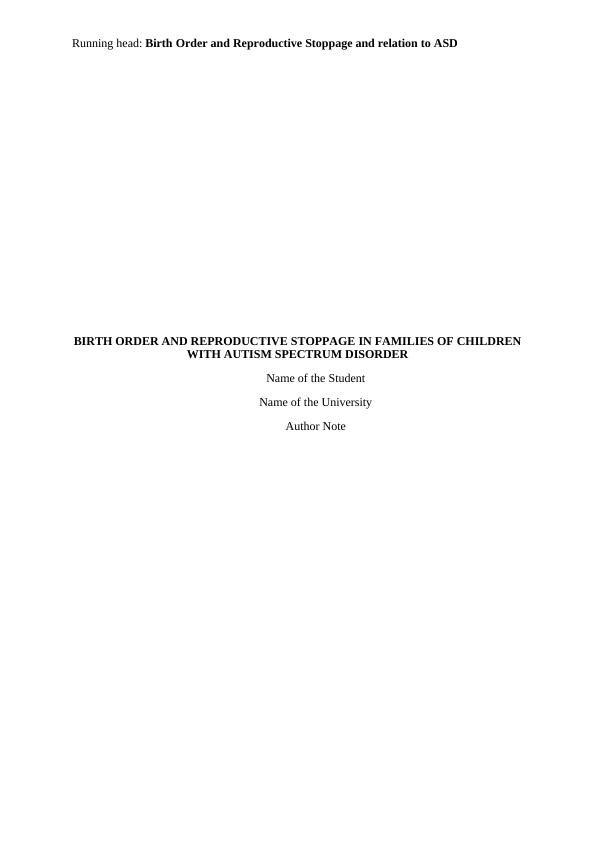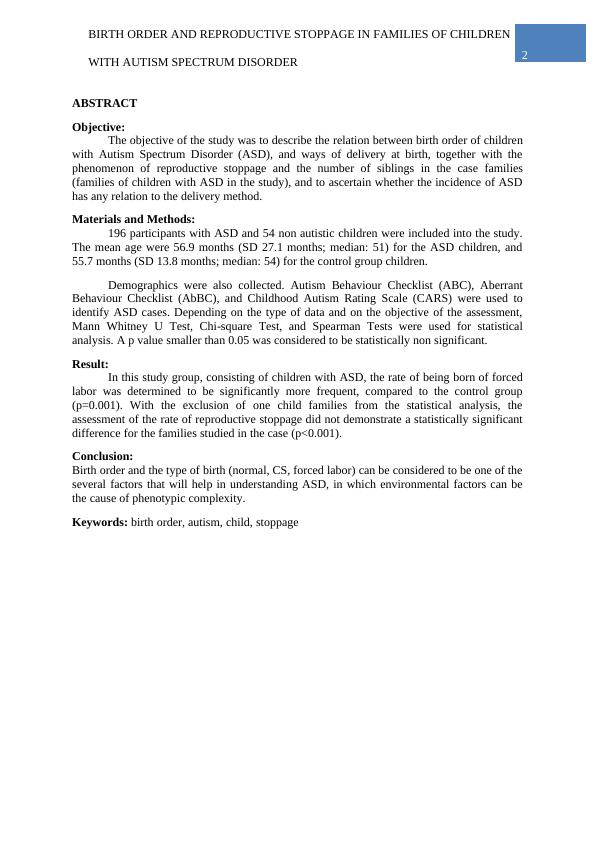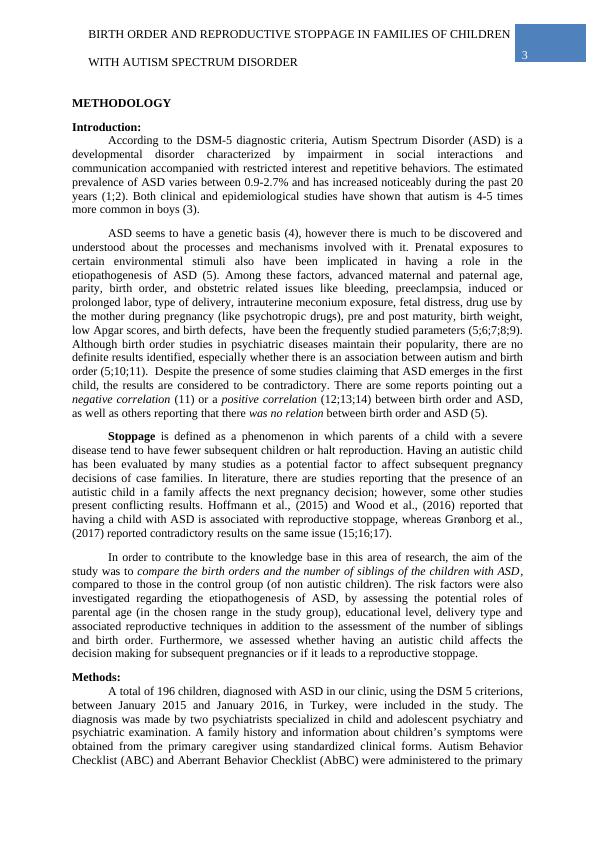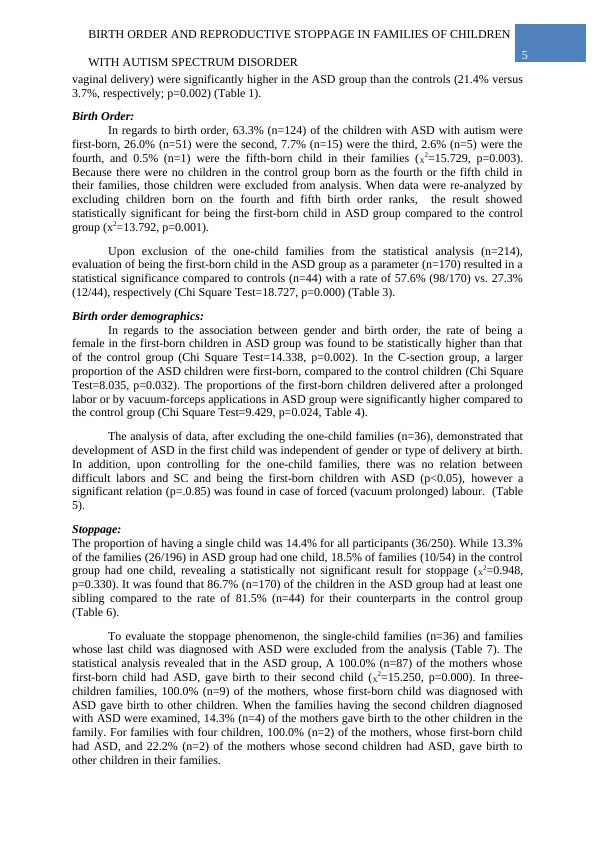Ask a question from expert
Birth Order and Reproductive Stoppage and Relation to ASD
21 Pages7440 Words140 Views
Added on 2020-04-21
Birth Order and Reproductive Stoppage and Relation to ASD
Added on 2020-04-21
BookmarkShareRelated Documents
Running head: Birth Order and Reproductive Stoppage and relation to ASDBIRTH ORDER AND REPRODUCTIVE STOPPAGE IN FAMILIES OF CHILDRENWITH AUTISM SPECTRUM DISORDERName of the StudentName of the UniversityAuthor Note

1BIRTH ORDER AND REPRODUCTIVE STOPPAGE IN FAMILIES OF CHILDREN WITH AUTISM SPECTRUM DISORDERContentsABSTRACT...............................................................................................................................2Objective:...............................................................................................................................2Materials and Methods:..........................................................................................................2Result:....................................................................................................................................2Conclusion:............................................................................................................................2METHODOLOGY.....................................................................................................................3Introduction:...........................................................................................................................3Methods:.................................................................................................................................3RESULTS:.................................................................................................................................4Demographics:...................................................................................................................4Birth Order:.......................................................................................................................5Birth order demographics:.................................................................................................5Stoppage:............................................................................................................................5DISCUSSION:...........................................................................................................................6Limitations:............................................................................................................................7Acknowledgements:....................................................................................................................8Compliance with Ethical Standards:.........................................................................................8Informed Consent:......................................................................................................................8Disclosure of potential conflicts of interest:..............................................................................8Research involving human participants and/or animals:..........................................................8REFERENCES:..........................................................................................................................9TABLES:..................................................................................................................................12Table 1..................................................................................................................................12Table 2..................................................................................................................................13Table 3..................................................................................................................................13Table 4..................................................................................................................................14Table 5..................................................................................................................................15Table 6..................................................................................................................................16Table 7..................................................................................................................................16Appendix..................................................................................................................................17

2BIRTH ORDER AND REPRODUCTIVE STOPPAGE IN FAMILIES OF CHILDREN WITH AUTISM SPECTRUM DISORDERABSTRACTObjective:The objective of the study was to describe the relation between birth order of childrenwith Autism Spectrum Disorder (ASD), and ways of delivery at birth, together with thephenomenon of reproductive stoppage and the number of siblings in the case families(families of children with ASD in the study), and to ascertain whether the incidence of ASDhas any relation to the delivery method.Materials and Methods:196 participants with ASD and 54 non autistic children were included into the study.The mean age were 56.9 months (SD 27.1 months; median: 51) for the ASD children, and55.7 months (SD 13.8 months; median: 54) for the control group children.Demographics were also collected. Autism Behaviour Checklist (ABC), AberrantBehaviour Checklist (AbBC), and Childhood Autism Rating Scale (CARS) were used toidentify ASD cases. Depending on the type of data and on the objective of the assessment,Mann Whitney U Test, Chi-square Test, and Spearman Tests were used for statisticalanalysis. A p value smaller than 0.05 was considered to be statistically non significant. Result:In this study group, consisting of children with ASD, the rate of being born of forcedlabor was determined to be significantly more frequent, compared to the control group(p=0.001). With the exclusion of one child families from the statistical analysis, theassessment of the rate of reproductive stoppage did not demonstrate a statistically significantdifference for the families studied in the case (p<0.001).Conclusion:Birth order and the type of birth (normal, CS, forced labor) can be considered to be one of theseveral factors that will help in understanding ASD, in which environmental factors can bethe cause of phenotypic complexity.Keywords: birth order, autism, child, stoppage

3BIRTH ORDER AND REPRODUCTIVE STOPPAGE IN FAMILIES OF CHILDREN WITH AUTISM SPECTRUM DISORDERMETHODOLOGYIntroduction:According to the DSM-5 diagnostic criteria, Autism Spectrum Disorder (ASD) is adevelopmental disorder characterized by impairment in social interactions andcommunication accompanied with restricted interest and repetitive behaviors. The estimatedprevalence of ASD varies between 0.9-2.7% and has increased noticeably during the past 20years (1;2). Both clinical and epidemiological studies have shown that autism is 4-5 timesmore common in boys (3).ASD seems to have a genetic basis (4), however there is much to be discovered andunderstood about the processes and mechanisms involved with it. Prenatal exposures tocertain environmental stimuli also have been implicated in having a role in theetiopathogenesis of ASD (5). Among these factors, advanced maternal and paternal age,parity, birth order, and obstetric related issues like bleeding, preeclampsia, induced orprolonged labor, type of delivery, intrauterine meconium exposure, fetal distress, drug use bythe mother during pregnancy (like psychotropic drugs), pre and post maturity, birth weight,low Apgar scores, and birth defects, have been the frequently studied parameters (5;6;7;8;9).Although birth order studies in psychiatric diseases maintain their popularity, there are nodefinite results identified, especially whether there is an association between autism and birthorder (5;10;11). Despite the presence of some studies claiming that ASD emerges in the firstchild, the results are considered to be contradictory. There are some reports pointing out anegative correlation (11) or a positive correlation (12;13;14) between birth order and ASD,as well as others reporting that there was no relation between birth order and ASD (5). Stoppage is defined as a phenomenon in which parents of a child with a severedisease tend to have fewer subsequent children or halt reproduction. Having an autistic childhas been evaluated by many studies as a potential factor to affect subsequent pregnancydecisions of case families. In literature, there are studies reporting that the presence of anautistic child in a family affects the next pregnancy decision; however, some other studiespresent conflicting results. Hoffmann et al., (2015) and Wood et al., (2016) reported thathaving a child with ASD is associated with reproductive stoppage, whereas Grønborg et al.,(2017) reported contradictory results on the same issue (15;16;17). In order to contribute to the knowledge base in this area of research, the aim of thestudy was to compare the birth orders and the number of siblings of the children with ASD,compared to those in the control group (of non autistic children). The risk factors were alsoinvestigated regarding the etiopathogenesis of ASD, by assessing the potential roles ofparental age (in the chosen range in the study group), educational level, delivery type andassociated reproductive techniques in addition to the assessment of the number of siblingsand birth order. Furthermore, we assessed whether having an autistic child affects thedecision making for subsequent pregnancies or if it leads to a reproductive stoppage.Methods:A total of 196 children, diagnosed with ASD in our clinic, using the DSM 5 criterions,between January 2015 and January 2016, in Turkey, were included in the study. Thediagnosis was made by two psychiatrists specialized in child and adolescent psychiatry andpsychiatric examination. A family history and information about children’s symptoms wereobtained from the primary caregiver using standardized clinical forms. Autism BehaviorChecklist (ABC) and Aberrant Behavior Checklist (AbBC) were administered to the primary

4BIRTH ORDER AND REPRODUCTIVE STOPPAGE IN FAMILIES OF CHILDREN WITH AUTISM SPECTRUM DISORDERcaregivers of children with ASD (18;19;20;21). Another scale, the Childhood Autism RatingScale scores (CARS) was administered by an experienced child and adolescent psychiatrist(22). Autistics with chronic diseases or malignancies were excluded from the study. Thecontrol group consisted of 54 children without ASD who presented to the pediatric outpatientclinic for vaccination and their ages and genders matched with the study group. A familyhistory and information about children’s symptoms were obtained from the primary caregiverusing standardized clinical forms.Maternal and paternal age and their educational levels, patient age, number ofsiblings, birth order, type of delivery at birth, assisted reproductive techniques and the impactof both being the first-born child and having ASD on reproductive behavior of case familieswere the parameters to be examined. Statistical analysis was performed via IBM SPSSStatistics for Windows, version 17.0. All continuous variables were defined as means andstandard deviations (SD), whereas categorical ones were assessed by frequencies andpercentages. Comparisons were performed by Student-T test or Mann Whitney U test andPearson chi-square test as its non-parametric equivalents. A ‘p’ value of ‘0.05’ wasconsidered to be statistically significant. To conduct the study, approval of the local ethicscommittee was obtained. Informed consent was obtained from all individual participants andtheir legal representatives.Reproductive stoppage was analyzed based on the incidence of a child birth, after achild with ASD was already done. However, due to limitations of the timeframe, the studycould not observe whether the families analyzed to have reached a reproductive stoppagehave had a child beyond the timeframe of the study conducted. An extension of the study canbe done by future observations of these families to ascertain if they continue to be inreproductive cessation.In total, 250 participants from Turkey, consisting of 54 control children without ASDand 196 children with ASD, diagnosed according to DSM-5 criteria, were included into thestudy. RESULTS:Demographics:The mean age of the children with ASD and the controls were 56.9 months (SD 27.1months; median: 51), and 55.7 months (SD 13.8 months; median: 54), respectively. P Value(Claculated Probability) or Hypothesis Testing and Chi Square Test showed that there wasno significant difference between the two groups in terms of age (p>0.05). The maternal andpaternal ages of children with ASD with ASD was higher than those of controls, though therewas no statistical significance (p>0.05) (Table 1). In the ASD group, 163 children with ASD (83.2%) were males and 33 children withASD (16.8%) were females. In the healthy control group, 47 children (%85.1) were malesand 7 children (%14.9) were females. There was no significant difference between the twogroups in terms of gender (p>0.05).The rates of spontaneous vaginal delivery and Caesarean section (C-section) weresimilar between the children with ASD and the controls (p>0.05). The rates of assistedreproductive techniques (including in vitro fertilization) were similar between the groups(p>0.05). Difficulties experienced during labor (prolonged labor, vacuum or forceps-assisted

5BIRTH ORDER AND REPRODUCTIVE STOPPAGE IN FAMILIES OF CHILDREN WITH AUTISM SPECTRUM DISORDERvaginal delivery) were significantly higher in the ASD group than the controls (21.4% versus3.7%, respectively; p=0.002) (Table 1). Birth Order:In regards to birth order, 63.3% (n=124) of the children with ASD with autism werefirst-born, 26.0% (n=51) were the second, 7.7% (n=15) were the third, 2.6% (n=5) were thefourth, and 0.5% (n=1) were the fifth-born child in their families (X2=15.729, p=0.003).Because there were no children in the control group born as the fourth or the fifth child intheir families, those children were excluded from analysis. When data were re-analyzed byexcluding children born on the fourth and fifth birth order ranks, the result showedstatistically significant for being the first-born child in ASD group compared to the controlgroup (x2=13.792, p=0.001). Upon exclusion of the one-child families from the statistical analysis (n=214),evaluation of being the first-born child in the ASD group as a parameter (n=170) resulted in astatistical significance compared to controls (n=44) with a rate of 57.6% (98/170) vs. 27.3%(12/44), respectively (Chi Square Test=18.727, p=0.000) (Table 3).Birth order demographics:In regards to the association between gender and birth order, the rate of being afemale in the first-born children in ASD group was found to be statistically higher than thatof the control group (Chi Square Test=14.338, p=0.002). In the C-section group, a largerproportion of the ASD children were first-born, compared to the control children (Chi SquareTest=8.035, p=0.032). The proportions of the first-born children delivered after a prolongedlabor or by vacuum-forceps applications in ASD group were significantly higher compared tothe control group (Chi Square Test=9.429, p=0.024, Table 4). The analysis of data, after excluding the one-child families (n=36), demonstrated thatdevelopment of ASD in the first child was independent of gender or type of delivery at birth.In addition, upon controlling for the one-child families, there was no relation betweendifficult labors and SC and being the first-born children with ASD (p<0.05), however asignificant relation (p=.0.85) was found in case of forced (vacuum prolonged) labour. (Table5). Stoppage:The proportion of having a single child was 14.4% for all participants (36/250). While 13.3%of the families (26/196) in ASD group had one child, 18.5% of families (10/54) in the controlgroup had one child, revealing a statistically not significant result for stoppage (X2=0.948,p=0.330). It was found that 86.7% (n=170) of the children in the ASD group had at least onesibling compared to the rate of 81.5% (n=44) for their counterparts in the control group(Table 6). To evaluate the stoppage phenomenon, the single-child families (n=36) and familieswhose last child was diagnosed with ASD were excluded from the analysis (Table 7). Thestatistical analysis revealed that in the ASD group, A 100.0% (n=87) of the mothers whosefirst-born child had ASD, gave birth to their second child (X2=15.250, p=0.000). In three-children families, 100.0% (n=9) of the mothers, whose first-born child was diagnosed withASD gave birth to other children. When the families having the second children diagnosedwith ASD were examined, 14.3% (n=4) of the mothers gave birth to the other children in thefamily. For families with four children, 100.0% (n=2) of the mothers, whose first-born childhad ASD, and 22.2% (n=2) of the mothers whose second children had ASD, gave birth toother children in their families.

End of preview
Want to access all the pages? Upload your documents or become a member.
Related Documents
Psychology Assignment: Autism Spectrum Disorder - Deskliblg...
|8
|2660
|316
Multiple Baseline Design in Psychologylg...
|5
|459
|31
TMA03 - Question 3lg...
|6
|1217
|73